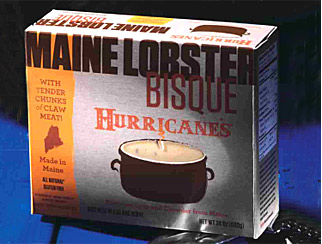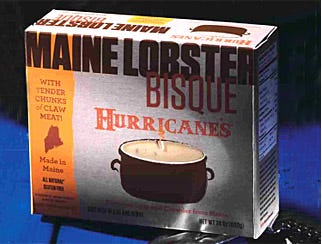How bag-in-box packaging helps New England deli storm into retail 4736
January 30, 2014


Hurricane
Hurricane's Premium Soup and Chowder, Greene, ME, takes its high-end product to retail shelves thanks to the cost efficiencies and packing ease of bag-in-box packaging in smaller quantities.
The food manufacturing business started as a family-operated New England café and deli co-owned by Philip (Phil) and Lorraine Wilbur, with their daughter "Hurricane" Kirsten Shovilin and her husband Joseph, in 2005. Since then, the café has gained notoriety for soups and chowders, which capitalized on the flavors of all natural, local ingredients, and enjoyed soup sales that quadrupled in volume in a single year.
Although Phil Wilbur relishes the café success, he has larger ambitions for the family's product. "I've always wanted to bring a product to market retail," he explains.
From restaurateur to manufacturer
The family had 1,500 sq-ft of unused warehouse space adjacent to the café, which could serve as the food manufacturing and packing area, so they began to explore what was necessary to start packaging its soups and chowders.
When other restaurants learned about Hurricane's efforts, they started inquiring about food service packs of its soups. Recognizing an immediate market need, Hurricane's produced its first food service pack in May 2009 utilizing equipment and packaging sourced at PACK EXPO International 2008. At time of publication, the café is debuting its retail packaging.
Leveraging local resources
Hurricane's food-service packaging consisted of two 1-gal Plascon Packaging Cook-Chill bags made with Cryovac C5045 shrink film housed in printed corrugated paperboard sourced from International Paper. "International Paper-they're a huge company, but our cases are actually made eight miles from here," remarks Wilbur. "It's a huge company, but also a local resource.
"So I was talking to my International Paper rep Brian Lebel, and he said, ‘Definitely talk to Bill at J. S. McCarthy. This is the company's niche, billing smaller runs,'" Wilbur recalls.
This was welcome news because some of the packaging options that Hurricane's had considered earlier required large minimum quantities, which made the packages very price prohibitive. "We were seriously considering a standup pouch for our retail package," Wilbur explains. "The problem we ran into with that was the enormous minimum quantities."
Building a better box
Wilbur contacted Bill Olmstead at J.S. McCarthy Printers and began development on an initial retail packaging concept that would leverage Hurricane's existing filling equipment and enable a first run of only 40,000 packages: smaller 24-oz Plascon Cook-Chill bags housed in die-cut, paperboard packaging.
After determining the initial concept, Olmstead brought in Yes! Marketing Group to further refine the package structure and design.
The first packaging element that Yes! tackled was the packaging structure. "They had been working toward a flatter, narrower, wider package," Sheldon Perkins, partner and marketing strategist at Yes! recalls. "In the process of looking at the product and how it would fit into a package like that and also the nature of the product, we concluded that it's not really a long flat product."
The agency suggested that the bags be folded in half before being inserted into the paperboard sleeves. This would enable the same bags to fit into squatter boxes and stand up better on the shelf.
Yes! also changed the location of the perforated tear strip. "It was originally oriented on the secondary information panel on the right-hand side as you face the label, which is where the nutrition facts go," Perkins recalls. "So we flipped the die [for the perforated strip] around."
One packaging element that the agency made sure not to significantly change was the logo design. "Phil's in the position of interpreting his daughter's logo design through someone else's eyes and design sense," Perkins explains. "This obviously is a very personal thing and makes him very close to the logo."
The final package design uses the Hurricane's logo as the primary graphic with consistent type and some branded colors throughout all varieties. Each variety of soup is identified with bold type at the top of the box and a bright color band on the left side with product-specific type.
The entire package development and design process took about two weeks, and fees were adjusted to fit Hurricane's budget. "To help us get the packaging off the ground, Yes! is being gentle on us," Wilbur remarks. "The package design work to get three flavors on the market is about $1,500."
Package reproduction
The completed files were sent to J.S. McCarthy, where they were put through a preflight process before entering the converter's PDF workflow. Because the printer works closely with its design partners, including Yes!, and according to the G7 method, J.S. McCarthy typically receives very clean files. "Typically color correction is not necessary," Rick Tardiff, president and CEO of J.S. McCarthy, explains.
Utilizing its Kodak Prinergy-powered workflow system, J.S. McCarthy creates soft proofs that can be viewed and adjusted by clients online. After the content for a package design job, such as Hurricane's, is finalized, two sets of proofs are made.
The first hard proof is imaged on an Epson inkjet printer and conveys the color intent; the second hard proof is made on a CAD plotter with the actual stock to verify that the packaging structure is correct. Using its HP Indigo press, J.S. McCarthy also digitally printed the packages that grace PD's cover. These are the first retail packages distributed by Hurricane's.
Although the design incorporates heavy ink coverage throughout, J.S. McCarthy is confident that it will be able to maintain the screens despite the wide bands of nearly solid colors with reversed type all in process. It will start by imaging Fuji plates using 20-micron stochastic screening by a Kodak Magnus CtP device. The plates will be mounted on a 40-in. Komori LS 8-color sheetfed press, which will lay Toyo Hy-Plus 100-a solvent-free offset ink that is manufactured to not chalk or ghost on press and works well with the aqueous coating chosen for Hurricane's packaging-on 24-pt C1S stock. The printed package will be finished on a Brausse flatbed die-cutter and an SBL Machinery folder/gluer.
All of this machinery is powered by wind-generated electricity. Using a certified 100 percent wind-powered converter enables Hurricane's to use the "Printed with Certified Wind Power" logo on its retail packaging.
Packing process
Because it uses Cook-Chill bags for the retail and food packaging, Hurricane's did not necessitate any changes to its existing filling line. Soups and chowders are pumped from kettles, which incorporate automated agitation ensuring consistent distribution of particulates throughout the liquid, to a Unifiller Systems XL piston filler.
Capable of up to 3,000 deposits/hour, the filler can be manually adjusted to change the amount of soup deposited. Operators manually place bags for filling. Product changeover is eased by quick and easy disassembly. "Cleaning is a cinch," Wilbur remarks. "The machine just pulls right apart."
Labels are printed using a small, desktop printer, which enables Hurricane's to print on demand and make changes on the fly. Labels are hand-applied to bags. After filling, the bags are weighed before being sealed using a foot-activated heat sealer. The bags then go into a chiller before being placed in the secondary corrugated or paperboard packaging.
Adding jobs to the economy
Hurricane's currently has a dozen employees. Wilbur hopes the retail packaging operation will enable Hurricane's to contribute more jobs to the local economy, including four full-time employees in the manufacturing kitchen alone.
More information is available:
Packaging Machinery Manufacturers Institute (PMMI), 888/275-7664. www.pmmi.org
J.S. McCarthy Printers, 888/465-6241. www.jsmccarthy.com
Plascon Packaging, 888/584-4422. www.plascongroup.com
Sealed Air Cryovac, 800/391-5645. www.sealedair.com
Unifiller Systems Inc., 604/940-2233. www.unifiller.com
Yes! Marketing Group LLC, 207/846-3733. www.yes-mg.com
.
About the Author(s)
You May Also Like


